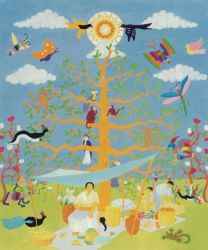What is Tamejavi?
The meaning behind the word Tamejavi
TAj laj Tshav Puam... (Hmong)
MErcado... (Spanish)
nunJAVI... (Mixteco)
Featured Media Released
The long-awaited release of the "From Our Roots" program is now available!
Support this program today.
Volunteer Opportunities
The Pan Valley Institute (PVI) needs the participation of individuals willing to donate their time...
Direction & Information
The Pan Valley Institute is located on West Shaw Avenue, near the northwest corner of Shaw and Fruit.
- 3649 W Beechwood Ave, Suite 102
Fresno, CA 93711 - (559) 222-7678
- (559) 222-7682
- infopvi@afsc.org
Tamejavi Festivals
Tamejavi 2002
In July 2001, at the offices of the Pan Valley Institute in Fresno, California, approximately 20 people gathered together for the first time to begin a dialogue and planning. The process lasted nine months, during which we hosted monthly meetings that provided participants space to exercise collective imagination. This group, called the Planning Committee, consisted of artists, communicators, organizers, and educators.

In the course of these gatherings, what began as a simple idea for a festival took another shape as new forms of artistic expression, forums, exhibits, and workshops were incorporated in the proposed program.
The idea to recreate a TAj laj Tshav Puam (Hmong), or MErcado (Spanish), or nunJAVI (Mixteco)—a marketplace—led to a cultural rapprochement without precedent. We discovered that all of us shared the same longing for such a public space in which we could exchange goods, songs, food, ideas, and news. This was a space in which we could gather together and dialogue about community issues, and a space in which popular artistic creations could be displayed and enjoyed. With this vision, in April 2002, the first Tamejavi Festival took place in the historic Tower District in Fresno, California.
Today, Tamejavi is not only a multimedia arts and cultural festival, but also a year-round learning community comprised of youth and elders, artists and organizers, chiefs and healers, educators and students. Through workshops, forums, exhibits, and cultural tours, we come together to explore complex and changing perspectives, as well as identities and the future of our democracy. We hope that our work can inspire others by being an example of how Valley communities can come together to exercise cultural and political rights through ongoing intercultural learning and collective action.


_001.jpg)
_001.jpg)
.jpg)
_001.jpg)
_001.jpg)
_001.jpg)
_001.jpg)
_001.jpg)
_001.jpg)